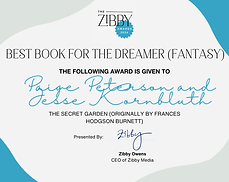The Secret Garden
Written by Frances Hodgson Burnett
Abridged by Jesse Kornbluth & Paige Peterson
Illustrated by Paige Peterson


.png)

Elaine Petrocelli and Paige Peterson at Book Passage

A new abridged version of the timeless classic
When we told friends that we were following our illustrated abridgements of “A Christmas Carol” and “Black Beauty” with “The Secret Garden,” we were stunned by the reaction. This turns out to be the favorite book of not just one generation, but of many. Every reader remembered the characters as if they were old friends: Mary, the frightened orphan sent from India to an ancient mansion in the English moors; Dickon, who can talk to the birds and make plants grow anywhere; and Colin, the physically challenged boy who’s spent his childhood in his bed. And everyone remembered cheering and weeping when Colin got out of his wheelchair and stood tall in the locked garden where his mother died and his endlessly sad father returns from yet another flight from his decade-long mourning and literally bumps into his son --- yes, “The Secret Garden” delivers an enormous emotional release.

“Every time you do a book we get so excited because our customers love the books and I love your books. You have such an incredible way of taking a classic and making it so appealing and yet still honoring the classic itself.”
Elaine Petrocelli, Founder and President of Book Passage

"This brand new beautiful edition of The Secret Garden by Paige Peterson and Jesse Kornbluth is just the thing for the new season of your life – any new season you choose. The story is timeless, vivid, created by pages of extraordinary color and delight by the delicious hand of Paige Peterson and even if you know the story you’ll live it again, love it and treasure it. It will make you feel young again!"
Judy Collins, award-winning singer songwriter


“I’ve always loved Paige Peterson’s illustrations — the ones she did for the book we created together, Blackie, the Horse Who Stood Still, were evocative and beautiful, and it’s all been uphill from there. For the wonderful abridgment of The Secret Garden that she and Jessie Kornbluth have just produced, Paige has truly outdone herself. She’s perfected a new painting-over-photographs technique to portray the old English architecture described in Frances Hodgson Burnett’s classic, and she couldn’t have made a more perfect choice. The new edition of The Secret Garden is absolutely stunning!”
Christopher Cerf, award-winning record and children's television producer

"The Secret Garden was one of my favorite childhood books! Paige Peterson and Jesse Kornbluth have renewed and polished this beloved children’s classic."
Joan Ganz Cooney, co-creator of Sesame Street

“Paige Peterson is an exceptional artist whose illustrations can even make
old classics shine like new.”
Zibby Owens, best-selling author, publisher and host of the


"Paige Peterson has done it again with her new updated children’s classic The Secret Garden. The multi-talented creative artist has not only enhanced photographs but has added her wonderfully interpretive drawings to the mix of illustrations. A true classic comes to life once again."
Harry Benson CBE, photographer
